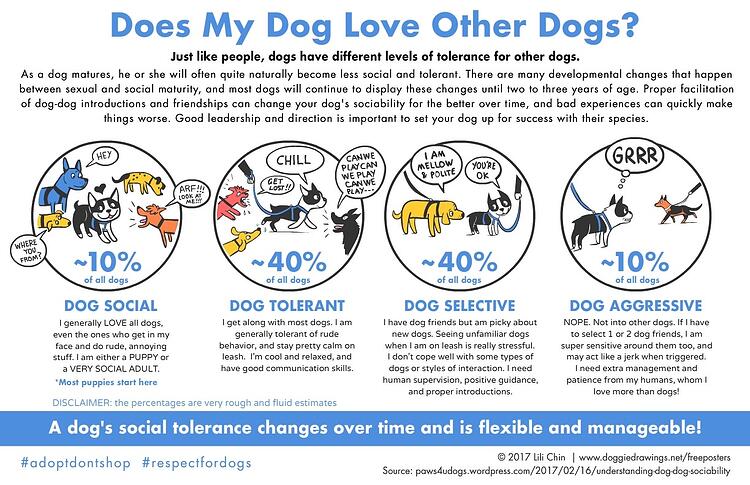As y’all know, this year’s training challenges are inspired by different categories of enrichment that we illustrate in our book Canine Enrichment for the Real World. This month’s challenge is inspired by one of the chapters we get a lot of questions about: social interaction (chapter 8). The challenge is:
Determine where your dog falls on the sociability chart
Emily and I like this chart (replacing the term “aggressive” for “solo”) illustrating the different levels of sociability.

One of my favorite things about this chart is that it clearly shows that far fewer dogs “love all other dogs” than American culture would have us believe. There’s this really pervasive myth in our culture that dogs should love everyone and everything, regardless of how the other individual is acting towards them. We expect them to be perfect all of the time. I don’t know about you, but that sounds not only exhausting but also impossible.
There are far more dogs who fall in the “Dog Tolerant” and “Dog Selective” categories. And that’s okay. Just like humans, there are dogs who don’t get along with everyone. There are those who have their friends and prefer to hang out with only them. There are those who have a large group of friends and others who have a small group. And all of that is okay, just like it is for humans. We’ve been domesticating them for a long time to hang out with us, not necessarily with other dogs. It’s only been in the last decade or so that we’ve seen a greater push for dogs to all play together.
When you’re going through this chart, take a step back and think about where your dog’s sociability is today, not when they were a puppy or even 6 months ago. Most puppies and adolescent dogs fall into the “Dog Social” category (though not all do). As they age, they usually leave that category and fit more accurately into another option. Needs and desires change with age and we should respect their current wishes instead of trying to adhere to who they used to be. I’m sure we would all ask others to do the same for us.
Additionally, it’s possible for sociability to change based on experience. I unfortunately have people reaching out to me fairly regularly because their dog has become selective or reactive (or even solo) after being attacked by or in a fight with another dog. Even one traumatic experience can change how they feel about new dogs as a whole.
So, it’s possible for a dog’s sociability to decrease, but how about increase? Sure. Behavior modification can help with that. One of the types of cases we work with most frequently is helping reactive dogs feel more comfortable around other members of their species. However, this behavior change can only be to a certain point. Learning history is only one factor that contributes to overall behavior. There are things that we can’t control or change, like age, genetics, and primary socialization periods. It’s unlikely that a dog in the “Dog Aggressive/Solo” category will move all the way up to the “Dog Social” category. We should set our sights on increasing sociability to the “Dog Selective” category instead, and I recommend having a behavior professional help you do that to make sure the process goes safely and smoothly.
The overall goal of this challenge is to be able to make more effective enrichment decisions based on where your dog’s sociability lies. Another myth that’s quite pervasive is that we need to be “socializing” our dogs with other dogs in order for them to live happy, fulfilling lives. But that’s only true for a certain subset (and it’s not actually socialization from a behavior standpoint after a certain age [I talk a bit about that here])! We should absolutely set up playtime for our “Dog Social” dogs and allow our “Dog Tolerant” and even some “Dog Selective” dogs to play with their friends in scenarios that they enjoy. But we can also meet social interaction needs by interacting with humans, especially for our “Dog Aggressive/Solo” and “Dog Selective” pets. I’ve met many dogs who are perfectly happy and well-enriched by interacting with humans alone.
Here are some options for activities that dogs can do together:
- Playtime (like well-run dog parks, daycares, boarding facilities, or just setting up a playdate in your yard)
- Walks & hiking
- Swimming
- Training together (and at a distance for our “Solo” and “Selective” friends!)
And activities for dogs to enjoy with their humans:
- Physical exercise games, like fetch and tug
- Mental exercise games, like scent work and hide and seek
- Training (especially trick training!)
- Cuddle time for those who enjoy it
- Walking & hiking
Now what?
- Figure out where your dog falls in the sociability chart
- Share your results with us by emailing us at [email protected] or connecting with us on Facebook @petharmonytraining.
Happy training,
Allie
